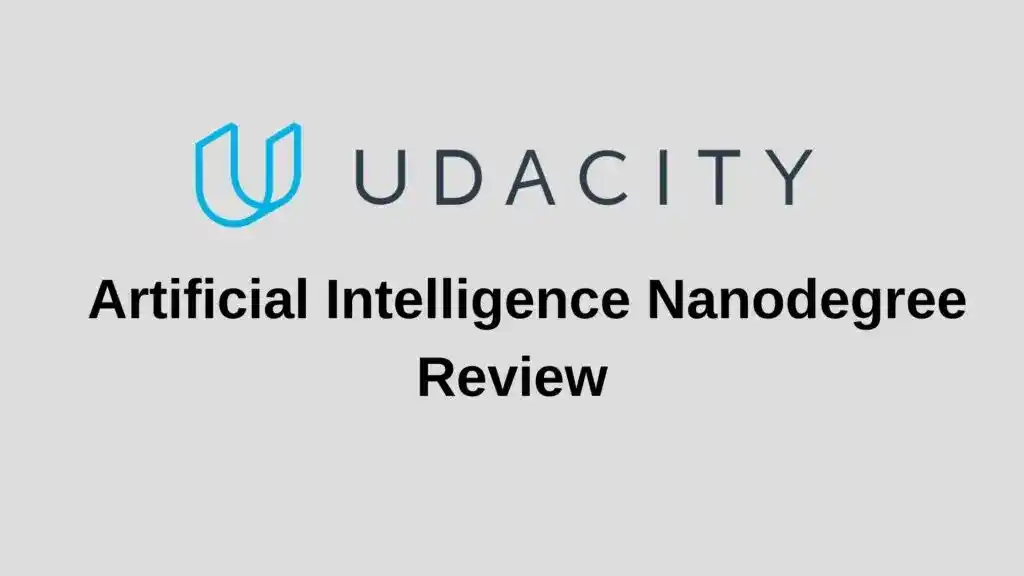In this article, I am going to share Udacity Artificial Intelligence Nanodegree Review with you. I hope this Udacity Artificial Intelligence Nanodegree Review will help you to decide whether this program is good for you or not.
So, without any further ado, let’s get started-
Udacity Artificial Intelligence Nanodegree Review
- Review Summary
- Udacity Artificial Intelligence Nanodegree Projects
- Udacity Artificial Intelligence Nanodegree Syllabus
- Udacity Artificial Intelligence Nanodegree Price and Time
- How to get a Discount on Udacity Artificial Intelligence Nanodegree?
- I completed the Nanodegree in Less Time
- Pros and Cons of Udacity Artificial Intelligence Nanodegree
- Who Should Enroll in Udacity Artificial Intelligence Nanodegree?
- Is Udacity AI Nanodegree Worth It?
- Conclusion
Review Summary
| Review Aspect | Experience |
|---|---|
| Curriculum | The curriculum was well-structured, covering essential AI topics with practical applications. However, you felt that certain topics were rushed, and some complex concepts could have been explained in more detail. |
| Hands-on Projects | The hands-on projects were engaging and provided valuable practical experience in AI development. However, you found some project instructions and guidelines to be slightly unclear, leading to some confusion during implementation. |
| Instructor Support | The instructors were generally knowledgeable and helpful, providing valuable feedback on projects. However, you experienced occasional instances of delayed responses to your queries, which you found frustrating. |
| Community | The student community and forums offered a supportive learning environment, promoting collaboration. However, you mentioned that the forum moderation could be improved, as some of your questions went unanswered for extended periods. |
| Flexibility | The self-paced learning approach allowed for a flexible schedule, which was beneficial to you. However, you found that the lack of fixed deadlines made it challenging to stay motivated and complete the course within a reasonable timeframe. |
| Value for Money | The Nanodegree’s cost was a concern for you, as you felt that the price could have been more competitive. However, you appreciated the value of the knowledge gained and the potential career opportunities the program offered. |
Artificial Intelligence is an emerging field. Various businesses are adopting AI technology in their business. Nowadays, you can see the application of AI in every field.
Artificial Intelligence makes machines so powerful that machines can take decisions by themselves. AI gives the machine the power of common sense, reasoning skills, and decision-making skills.
Self-Driven Cars, Robotics, Google Assistant/Siri/Alexa, Product Recommendation, chatbots, Image Recognition, and many more are the most popular applications of Artificial Intelligence.
To learn Artificial Intelligence, there are various courses and programs available. And Udacity Artificial Intelligence Nanodegree is one of them.
In this article, I will share whether you should enroll in the Udacity Artificial Intelligence Nanodegree or not after reviewing the Nanodegree Program.
As we know Artificial Intelligence is all about practice and implementing ideas. So, if any course doesn’t cover the practical part, I would say the course is not worth it. That’s why the first thing I checked in Udacity Artificial Intelligence Nanodegree was its projects.
Now, let’s see how many projects are covered in the Nanodegree Program, and will these projects help you.
Udacity Artificial Intelligence Nanodegree Projects
After enrolling in the program, I found that Udacity Artificial Intelligence Nanodegree doesn’t lack hands-on practice. That’s very helpful.
There are 4 projects throughout the Nanodegree Program. The main focus of these projects is to teach search, optimization, planning, and probabilistic graphical models.
Now, let’s see the first project of Udacity AI Nanodegree-
Project 1- Build a Sudoku Solver
This was the first project of the Nanodegree Program. This is a fun project where you have to build a Sudoku Solver AI Agent. This AI agent will solve the puzzle. We all heard about Sudoku and played. That’s why this project is not boring.
For this project, I had to use Python Programming Language. There was a solution.py file. And I had to write all code in this file. After completing the project, I had to submit the project in a zip file. And then the reviewer reviewed my project and gave feedback.
The best thing about Udacity was its technical mentor support feature. Throughout the project, you can ask the mentor.
Project 2- Build a Forward Planning Agent
The second project was not as easy as Project 1. Without having previous Python knowledge, it’s hard to complete this project. Udacity provided project rubrics where all the details were listed about the project.
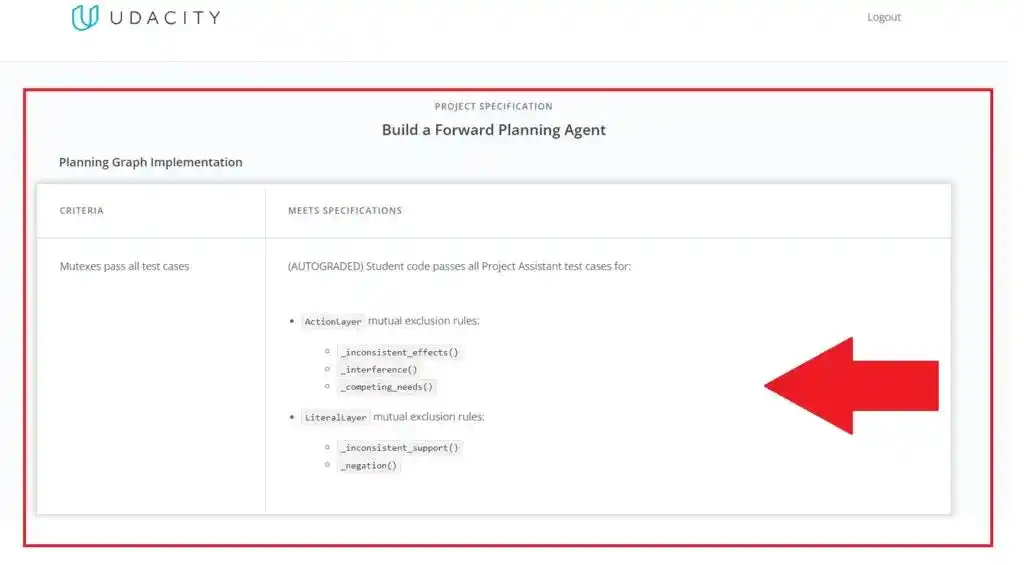
Udacity provided two options one is to complete the project in Udacity Workspace. Udacity configured the workspace with the required files and libraries for this project. This is the easiest way to complete this project.
The other option is to complete this project in your local environment. If you really want to learn and want to perform all the steps by yourself, then you can go with this option.
Project 3- Build an Adversarial Game Playing Agent
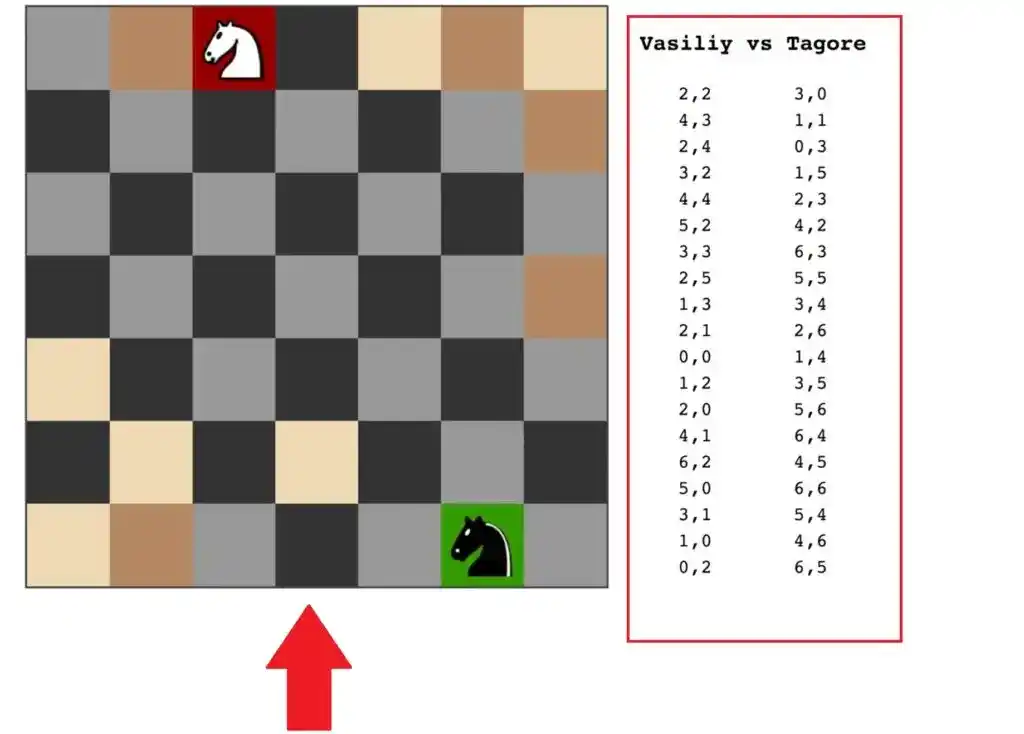
This was a fun game project. The objective of this project was to build an AI agent. And the agent has to play Knights Isolation.
There were two players in the game. And each player had to move from one cell to another cell.
For the evaluation of the report, Udacity gave three options-
- Advanced Heuristic
- Opening book
- Advanced Search Techniques
After completing the project, all the students need to submit their projects for review. The reviewer takes 1 week to review the project and sends an email after reviewing the project.
Project 4- Part of Speech Tagging
This was the last project of this Udacity Artificial Intelligence Nanodegree. In this project, I had to use the Pomegranate library for building a hidden Markov model for part of speech tagging.
The Pomegranate library is a Python library for implementing fast and flexible probabilistic models.
There was some code already present in the notebook. I had to only add some new features written in project rubrics to finish the project.
Overall, this was not an easy project. Some extra searches and documents are required to finish this project. The following steps are required in this project-
- Read and preprocess the dataset
- Build a Most Frequent Class tagger
- Build an HMM(Hidden Markov Model) tagger
So, this is all about the Udacity Artificial Intelligence Nanodegree Projects. Now, let’s see the Udacity Artificial Intelligence Nanodegree Syllabus or Content–
Udacity Artificial Intelligence Nanodegree Syllabus
Udacity Artificial Intelligence Nanodegree had 6 courses. And each course had some lessons. This is the details of the courses-
- Intro to Artificial Intelligence
- Classical Search
- Automated Planning
- Optimization Problems
- Adversarial Search
- Fundamentals of Probabilistic Graphical Models
Now, let’s see what I learned in all these courses.
Course 1- Intro to Artificial Intelligence
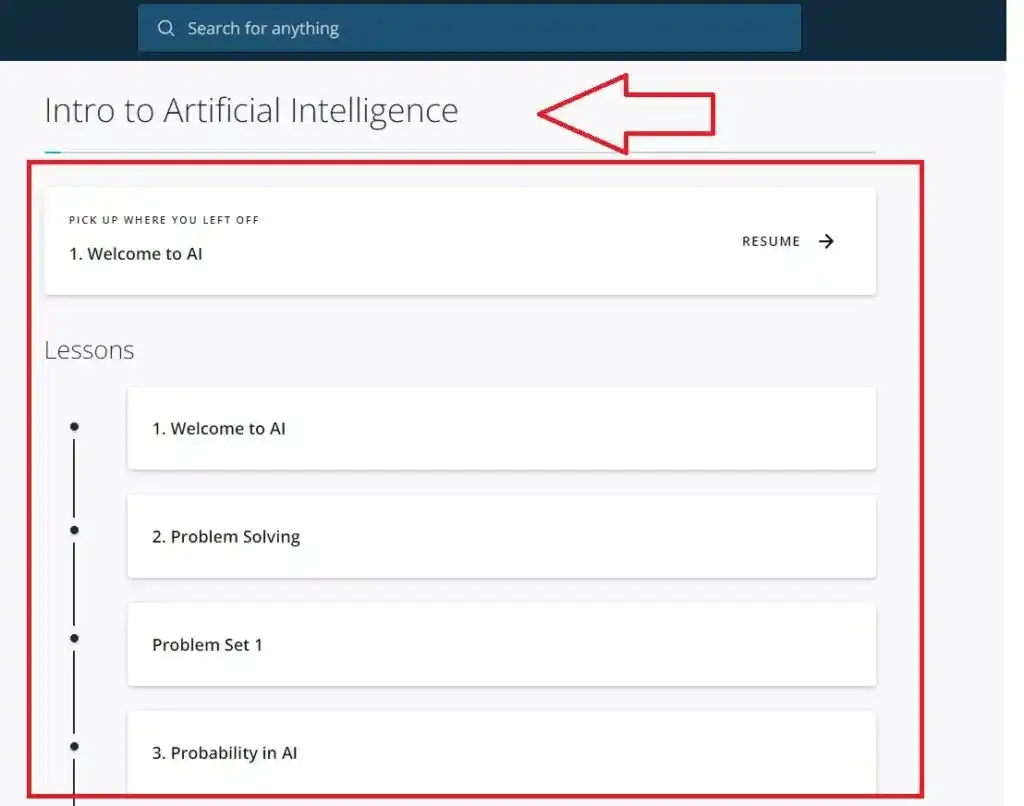
The name of this course is Introduction to AI, but this course was very in-depth. Sebastian Thrun was the instructor of this course.
The course began with the basics of AI and its applications. Then he explained Problem Solving and gave an example of route finding. In this course, I learn various search algorithms such as Tree Search, Graph Search, Breadth First Search, A* Search, etc.
The instructor also explained machine learning algorithms such as Unsupervised learning and Reinforcement Learning. Throughout this course, there were different problem sets and quizzes. Most of the tutorials were in video formats.
At the end of this course, the instructor explained the constraint satisfaction problem. Overall, I enjoyed and learned various new terms in this course.
The Suduko Solver Project was in this course.
Course 2- Classical Search
There are two types of search informed search and uninformed search. In this course, I learned about informed and uninformed searches and the differences between these two searches.
Informed search has different algorithms such as Depth-first and Breath first searches. And the uninformed search has an A* search algorithm. I learned all these algorithms too.
Overall, this was not a very long course. This course covered topics related to Classical search.
Course 3- Automated Planning
Planning is an essential step in Artificial Intelligence and this course was dedicated to it. This course covered technical topics such as Propositional Logic and First-Order logic.
The best thing, I found in this Nanodegree program were quizzes and exercises. These quizzes and exercises are designed in such a way that they can clear your doubts.
At the end of this course, there were some extra resources provided for learning. These external resources help you to dig a bit deeper.
Overall, I learned interesting and technical topics in this course.
Course 4- Optimization Problems
In this course, the instructor covered Optimization Problems. The concepts taught in this course were interesting and easy to understand. For eg. Random Hill Climbing.
Random Hill Climbing is a local search algorithm. The objective of Random Hill Climbing is to keep moving in the increasing direction to find the peak or best solution. The instructor explained this concept visually with the help of an example.
Next, he covered Genetic Algorithms. The Genetic Algorithms concept and its working procedure blew up my mind. But, I understood the whole concept because the instructor explained it very nicely.
Course 5- Adversarial Search
There was a separate course on Adversarial Search. Because this is an important topic in Artificial Intelligence. This course covered Adversarial Search in detail such as what is Adversarial Search, its applications, and various techniques.
Monte Carlo Tree Search is also a technique of Adversarial Search but this was not covered in this course. I don’t know why. But instructor gave extra resources for learning and in these resources, Monte Carlo Tree Search was there.
Course 6- Fundamentals of Probabilistic Graphical Models
This was the last course of Udacity Artificial Intelligence Nanodegree. I found that to understand this course, previous statistics knowledge is required.
For me, this was the toughest course in this Nanodegree Program. Probabilistic Models, Probability, and other complex statistics and probability methods are covered in this course.
If you don’t have previous statistical understanding, I would not suggest starting this course before learning basic statistics. When I started this course, I didn’t understand these concepts because my statistical knowledge is not good. So, I paused this course and watched this free course-> Intro to Statistics by Udacity.
After completing this course, I resumed the last course of Udacity Artificial Intelligence Nanodegree.
So, this is how I completed this Nanodegree Program.
Now let’s see the price and duration of the Udacity Artificial Intelligence Nanodegree program-
Udacity Artificial Intelligence Nanodegree Price and Time
According to Udacity, the Udacity Artificial Intelligence Nanodegree program will take 3 months to complete if you spend 12-15 hours per week. And for 3 months they cost around $800. But Udacity offers two options- One is either pay the complete amount upfront or you can pay monthly installments of $399/month.
Udacity
I would like to share the method I used while enrolling in the Nanodegree Program.
How to get a Discount on Udacity Artificial Intelligence Nanodegree?
Most of the time, Udacity offers some discounts. When they offer a discount, it appears something like that-
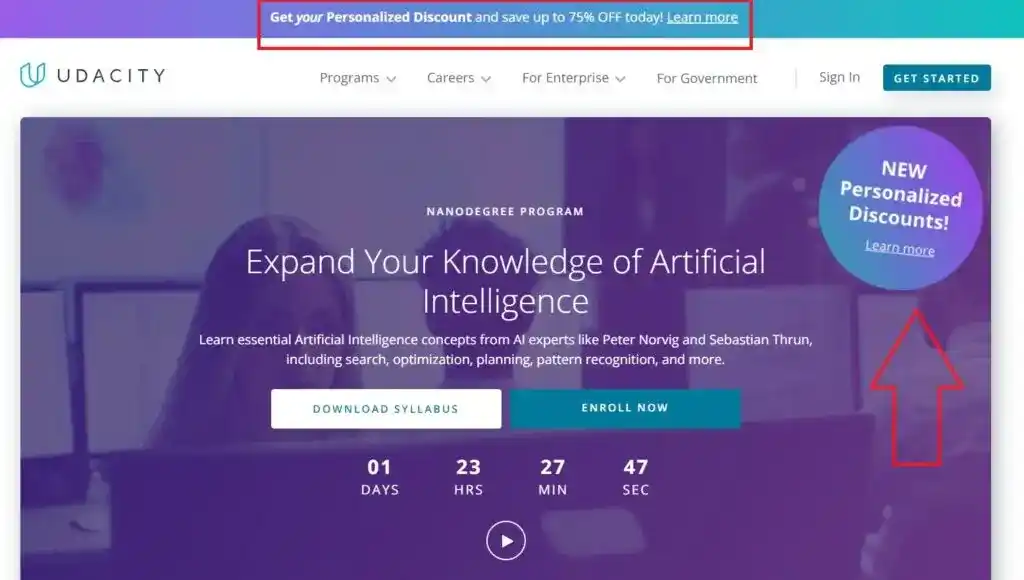
Click on the “Personalized Discount” button and Udacity will ask two questions. Answer these questions and based on these questions, Udacity gave a Discount Coupon.
You need to apply the coupon provided by Udacity at the time of checkout. And you will get a discount on the Udacity Artificial Intelligence Nanodegree program. So to get a discount on Udacity, you need to wait for their sale.
You can check the current Discount of Udacity here.
Another thing, I did for saving some money was-
I completed the Nanodegree in Less Time
To complete the Udacity Artificial Intelligence Nanodegree program in less time, I managed my time productively. That means I planned each day. Udacity also provided a calendar schedule, where you can manage your time.
But I used a separate planner and gave a good amount of time daily to the Nanodegree Program. For eg, If 2 hours are suggested by Udacity, So, I gave 4 hours.
By doing this, I completed the Nanodegree Program in 2 months and saved one month’s fees. The project takes more time. That’s why I would recommend reading project rubrics in detail.
If you follow any of these, you can save a few bucks.
Now, let’s see the Pros and Cons of Udacity Artificial Intelligence Nanodegree–
Pros and Cons of Udacity Artificial Intelligence Nanodegree
Pros-
- The course materials are well structured and overall have good quality.
- The projects are interesting and demanding.
- Peter Norvig and other instructors’ explanation is amazing and provide practical exposure.
- The Reviewer gives suggestions to improve the projects. This will help you to make your portfolio more valuable.
- You will get Technical mentor support and the mentor will guide you from the start of your Nanodegree program until you finish the whole program.
- Udacity provides a great community for help. They have a Stackoverflow-style Q&A forum for people who are stuck with assignments.
Cons-
- Udacity Nanodegree program is expensive as compared to other MOOCs platforms.
- After completing the Nanodegree program, you can’t access the course material. Maybe Udacity does this to avoid misuse.
- Udacity doesn’t have any IOS and android apps. So, you can’t study on your smartphones and outside the house.
Udacity Artificial Intelligence Nanodegree needs some prerequisites and without having prerequisite knowledge, you will not get 100% from Udacity Artificial Intelligence Nanodegree, and it will be a waste of money. So, let’s see the prerequisites of the Udacity Artificial Intelligence Nanodegree program–
Who Should Enroll in Udacity Artificial Intelligence Nanodegree?
You should enroll in this program if you know-
- Basic linear algebra and calculus.
- Basic probability and statistics.
- Python programming.
Along with that, you should know computer science algorithms and object-oriented programming.
If you meet the following prerequisites, then you can enroll in the Udacity Artificial Intelligence Nanodegree program. And if not, then you should first enroll in these FREE Courses-
Now, it’s time to answer this question-Is Udacity AI Nanodegree Worth It?
Is Udacity AI Nanodegree Worth It?
Udacity AI Nanodegree is worth it for those who want to gain practical exposure and learn Artificial Intelligence from industry experience Instructors. Udacity Artificial Intelligence Nanodegree is combined with Real-World projects. These projects will make your Portfolio strong. You will also get One-to-One Mentorship to clear your doubts while working on projects.
Conclusion
I hope this Udacity Artificial Intelligence Nanodegree Review helped you and cleared your doubts regarding the Udacity Artificial Intelligence Nanodegree program. If you have any doubts or questions regarding the “Udacity Artificial Intelligence Nanodegree Review“, feel free to ask me in the comment section.
If you found this Udacity Artificial Intelligence Nanodegree Review helpful, you can share it with others.
All the Best!
Similar Searches
8 Best Free Courses to Learn AI (Artificial Intelligence) in 2025
Best Certification Courses for Artificial Intelligence- Beginner to Advanced
Best Natural Language Processing Courses Online to Become Expert
Best Artificial Intelligence Courses for Healthcare You Should Know in 2025
What is Natural Language Processing? A Complete and Easy Guide
Best Books for Natural Language Processing You Should Read
Augmented Reality Vs Virtual Reality, Differences You Need To Know!
What is Artificial Intelligence Examples? Real-World Examples.
Explore more about Artificial Intelligence.
Thank YOU!
Though of the Day…
‘ Anyone who stops learning is old, whether at twenty or eighty. Anyone who keeps learning stays young.
– Henry Ford
Written By Aqsa Zafar
Founder of MLTUT, Machine Learning Ph.D. scholar at Dayananda Sagar University. Research on social media depression detection. Create tutorials on ML and data science for diverse applications. Passionate about sharing knowledge through website and social media.

